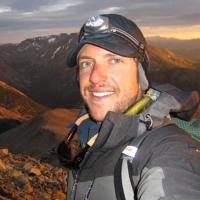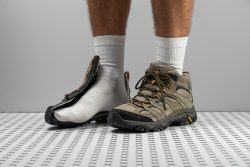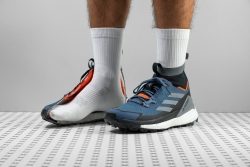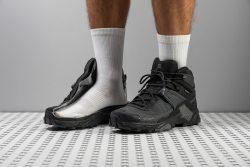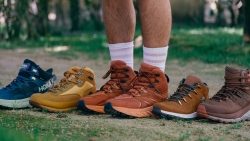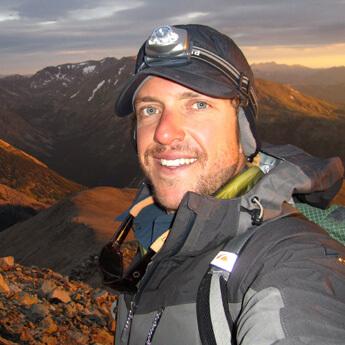6 Best Day Hiking Boots in 2025

We buy shoes ourselves. We earn commissions when you buy through us, at no extra cost. Why trust us
Whether you’ve just decided to start your hiking journey or are planning a hike with your friends, we’ve compiled the ultimate list of great-quality day hiking boots that we tested in our lab.
From high-cut style to mid and low-cut models, there’s a perfect fit for all types of outdoor enthusiasts, campers, and backpackers from top brands like Lowa, Danner, KEEN, and others. Whatever day hiking adventure you’re going on, these hikers provide you with that comfort, protection, and extra support you need.
With tonnes of superb options out there, picking the right pair can be mind-boggling. To save you time, we’ve tested day hiking boots on the trails and in our lab. Then, we ranked them accordingly. Take a look at the outstanding picks we found!
How we test day hiking boots
All the hiking boots in our database are tested on the mountains and in our lab. This is how our complete process looks like:
- We buy the day hiking boots out of our own pockets, which ensures that our top rankings and comprehensive reviews are devoid of bias.
- We wear the boots on our next-day hiking excursions to test their performance and value. We check each model’s comfort level, break-in time, traction, stability, breathability, waterproofness, protective features.
- We take the boots to the lab, where we use callipers, durometers, gel moulds, a smoke machine, and other tools to accurately measure different features.
- We publish reviews that reflect our first-hand hiking experience in the boots and lab results.
Best day hiking boots overall
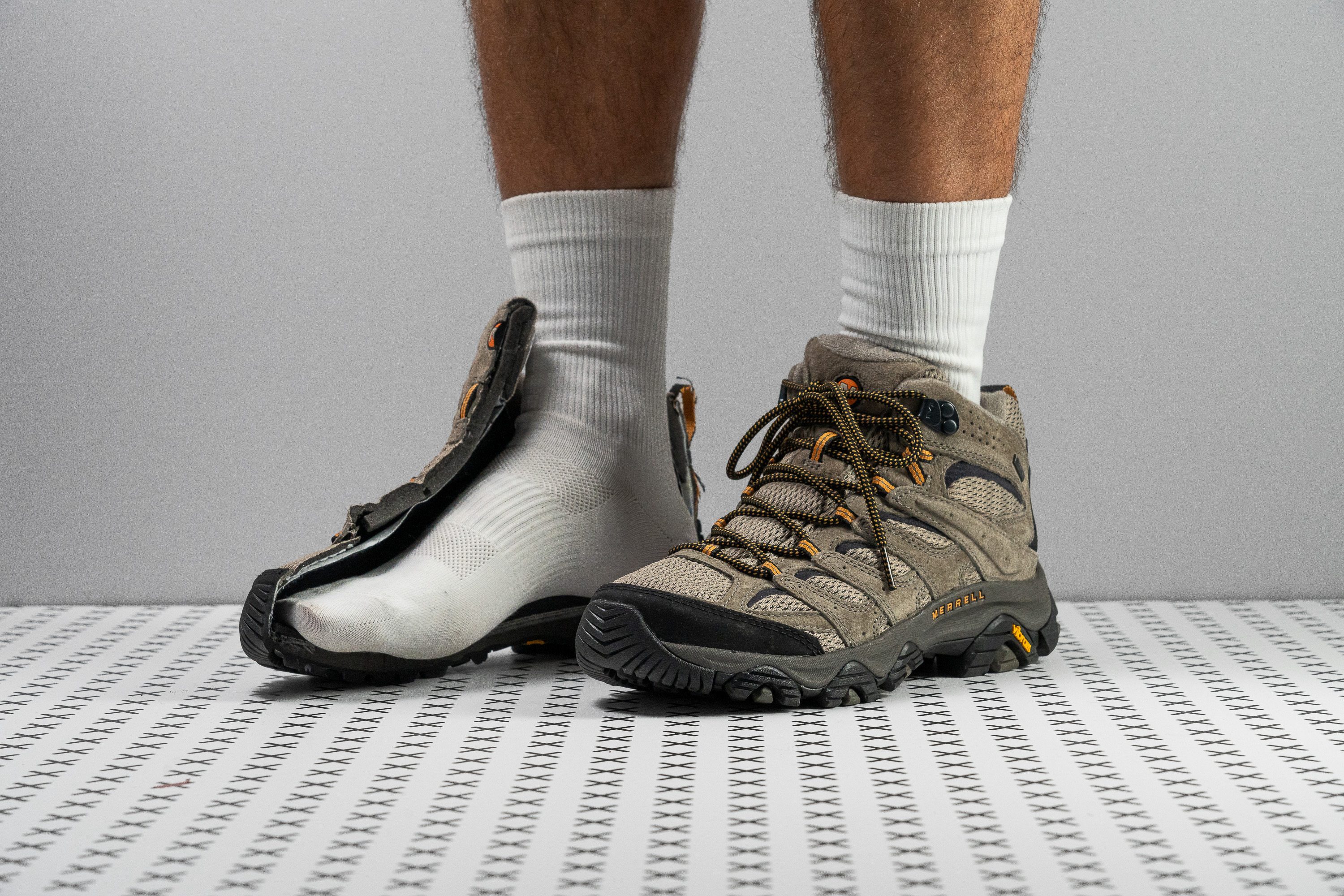






















































What makes it the best?
Numbers checked and mileage burned, we found Merrell Moab 3 Mid GTX as the ultimate day hiking boot. It’s tough on the outside and cosy on the inside, ensuring our comfort, stability, and protection as we tackle diverse trail conditions.
This boot is ready for the wilderness from top to bottom. The leather upper shields us from water, debris, and cold weather. Smoke barely escaped in our test, earning a 1/5 breathability score. Meanwhile, the Vibram outsole, equipped with deep 5.0 mm lugs, effectively secured our grip on wet rocks and slippery logs.
Our lab reveals a 36.1/22.6 mm stack for impact protection, muting sharp objects underfoot. Meanwhile, our durometer shows a firm 32.8 HA cushion for surefooted strides. However, it feels much softer thanks to the 24.6 HA Air Cushion.
Further adding to our stability is its rigid build, which prevents ankle collapsing that may lead to foot fatigue or injuries. Our manual assessment reveals a high 4/5 torsional rigidity because of the stiff nylon shank in the midfoot. To boost comfort, the boot is easily bendable, emerging 33.2% more flexible than average in our flex test.
Unfortunately, its lugs are not toothy enough for soft ground and mud. We grasped for branches and walking poles as we passed these surfaces. We recommend a boot with more aggressive lugs for these types of terrains.
Pros
- Best-in-class waterproofing
- Great stability for moderate hikes
- Supportive for all-day wear
- Comfortable step-in feel
- Excellent grip on hard terrain
- Secure lockdown
- Sturdy construction
- Sturdy construction
Cons
- Moderate impact protection
- Mesh panels are easy to tear
- Not for mud or soft terrain
- Moderate impact protection
Best city-to-trail day hiking boots
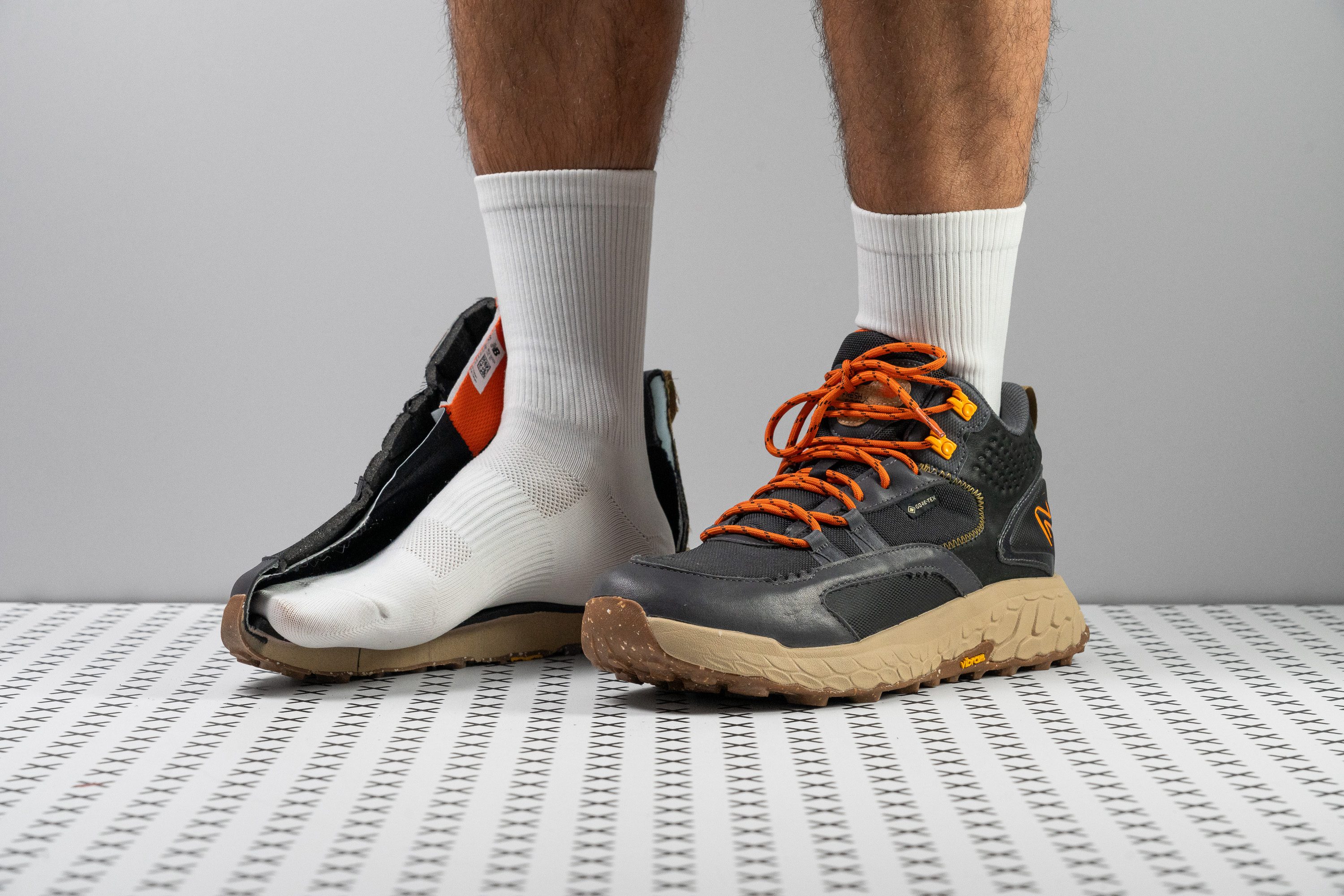









































What makes it the best?
We’re in awe of how the New Balance Fresh Foam X Hierro Mid GTX delivers sturdy support in its light and malleable build. Our transitions from gravel roads to neighbourhood sidewalks feel seamless, courtesy of the grippy Vibram outsole and effective lateral stability of the boot we verified in the lab. Among day hiking boots, it deserves the best city-to-trail title.
The Vibram Megagrip proves its elite status yet again, delivering superior traction and control on various surfaces. It features 4.1 mm lugs, which are studded with small dots to further enhance their bite on the ground.
We never felt like losing our footing on uneven terrain with the boot’s solid side-to-side containment. It has no give to twisting, proven by its maximum 5/5 torsional rigidity score in our manual assessment.
Even with its surefooted stability, the Hierro Mid GTX feels effortless on foot. Its light 13.7 oz (388g) never felt like a burden, making it comfortable for long hours of wear. It also displayed high flexibility in our bend test, emerging 29.8% more pliable than average.
The boot’s platform offers a plush feel underneath. However, hikers who prefer more ground feel should go for a boot that offers less shock absorption.
Pros
- One of the softest hiking boots
- Generous cushioning for long miles
- Much lighter than average boot
- Lively and bouncy ride
- Excellent stability and lockdown
- Flexible forefoot
- Effective waterproofing
- Durable upper and outsole
- Grippy on varied terrain
Cons
- Gets notably firmer in low temps
- Low flood level
- Not for technical terrain
Day hiking boots with the best shock absorption
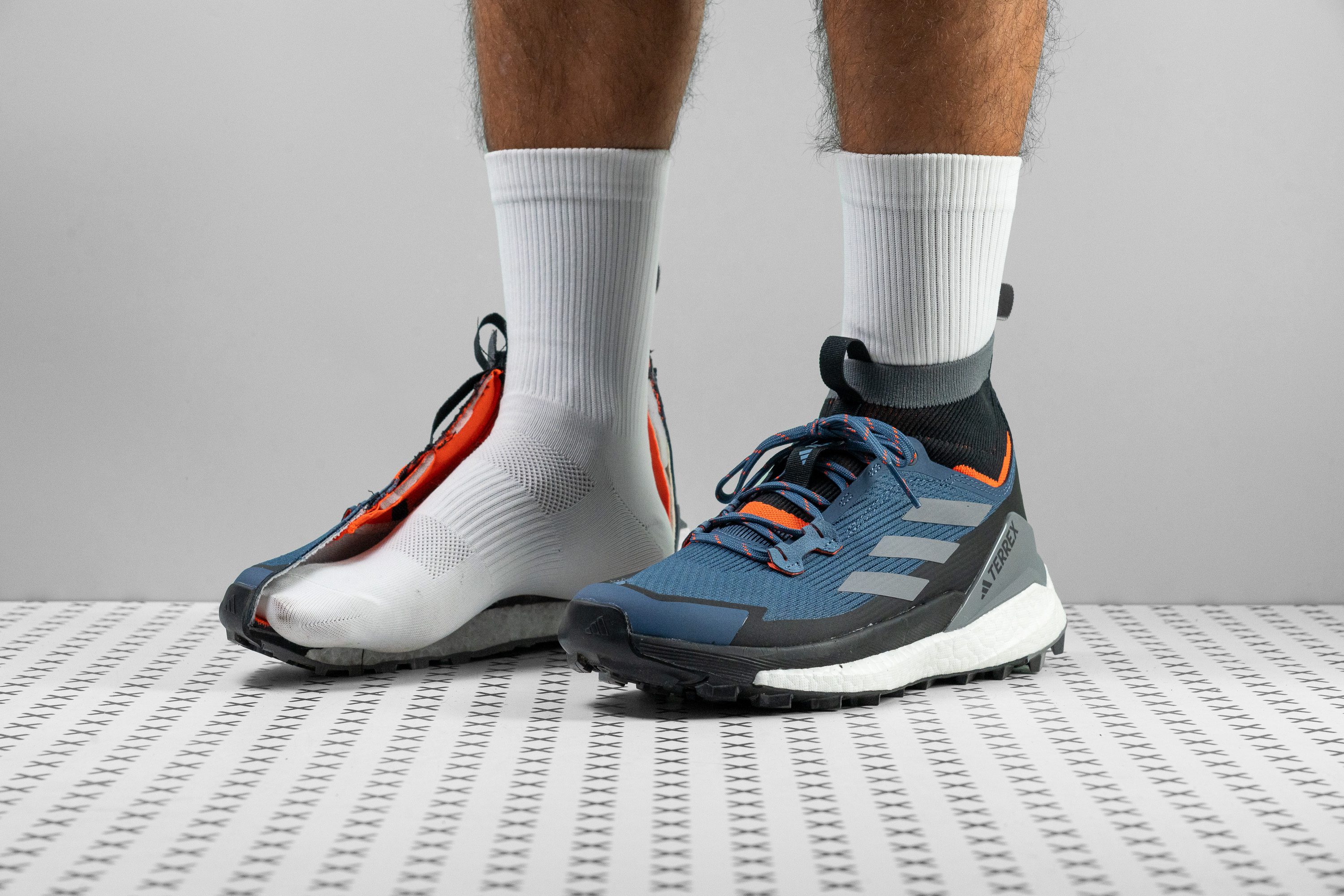














































What makes it the best?
We’re sure of it, through countless miles in the mountains and hours in the lab, the Adidas Terrex Free Hiker 2 is our day hiking boot with the best shock absorption. It offers leg-saving comfort and responsiveness in a lightweight and flexible package, making it a reliable partner for long hours of trekking.
The stack height measures a generous 38.4/24.0 mm, shielding us against underfoot hazards and harsh impact. It feels well-cushioned with every step, backed up by its high 121 SA or shock absorption score.
With each step, the springy midsole pushes us forward, almost making us want to speed hike. With its top-notch 66.0% energy return, we understood why the shoe felt so agile.
Another reason for its speed is its light 15.0 oz (425g) build. Being 20.0% below average, it almost feels like a trail shoe because it was just that easy on foot. We felt like we could hike endlessly in this boot. Plus, its flexibility enhances its weightless sensation. In our bend test, it emerged as a mind-blowing 49.2% more malleable than average.
To unlock its one-of-a-kind lightness, it requires deep pockets with its £200 price tag. Casual hikers or those on a budget can find comfy yet cheaper alternatives.
Pros
- Extremely well-cushioned
- Exceptionally lively and bouncy underfoot
- Luxuriously padded interior
- Grippy and durable lugs
- Tackles wet surfaces confidently
- Very flexible and forgiving
- Excellent airflow
- Feels incredibly stable underfoot
- Supportive heel collar
- Rockered midsole
- Relatively lightweight
- High-quality construction
- Eye-catching design
Cons
- Needs breaking in
- Tricky to put on
- Expensive
Day hiking boots with the best stability
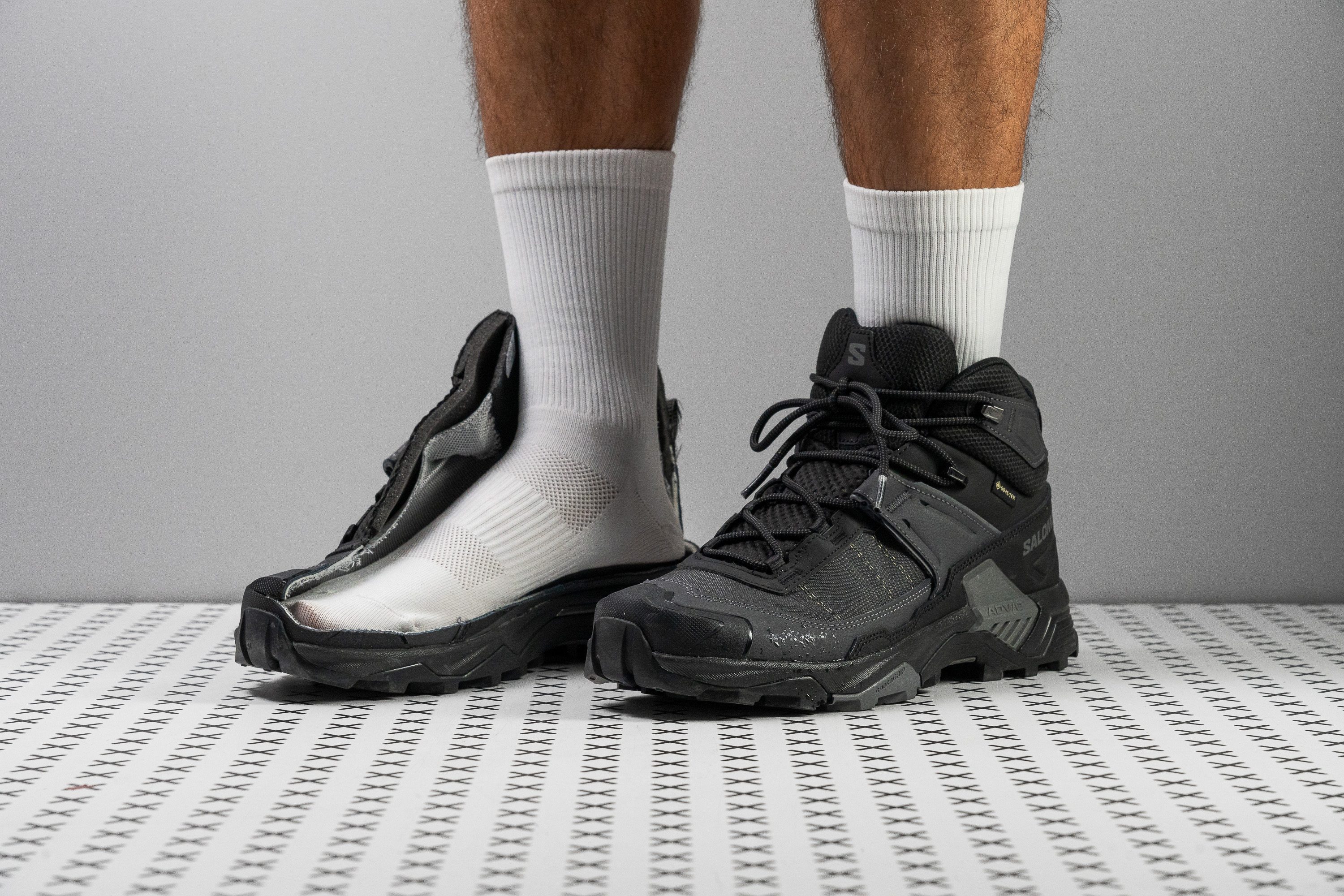











































What makes it the best?
Among the day hiking boots we brought to the mountains, the Salomon X Ultra 5 Mid GTX impressed us the most in terms of stability. It offers unwavering resistance against twisting, but allows forefoot bending, as confirmed by our lab results. Besides its flexibility, its light build creates a smooth and effortless experience.
Besides its mid-cut upper, the Advanced Chassis offers a strong foothold in the midfoot area, which prevents any chances of our feet losing balance. We attempted to twist the boot using our hands, and it had no give, so we gave it the maximum 5/5 torsional rigidity score.
Amazingly, its sturdy support doesn’t bring its weight down. Our scales confirm it’s only 15.4 oz (437g), 17.7% lighter than average, making it ideal for daily use. Moreover, the forefoot offers lots of room for movement, making the boot easy to manoeuvre in rocky portions. Our bend test confirms it’s 34.3% more pliable than average, boosting its comfort and versatility.
However, this boot focuses on a trail-connected experience. Those seeking deep cushioning and dealing with foot conditions such as plantar fasciitis should skip this pair.
Pros
- Stable and grounded platform
- Flexible forefoot adds manoeuvrability
- Great grip on wet terrain and rocks
- Surefooted on mixed and hilly trails
- Much lighter than average
- Excellent Gore-Tex waterproofing
- Tough and durable upper
Cons
- Minimal cushioning and shock absorption
- Not for deep mud
Best leather day hiking boots
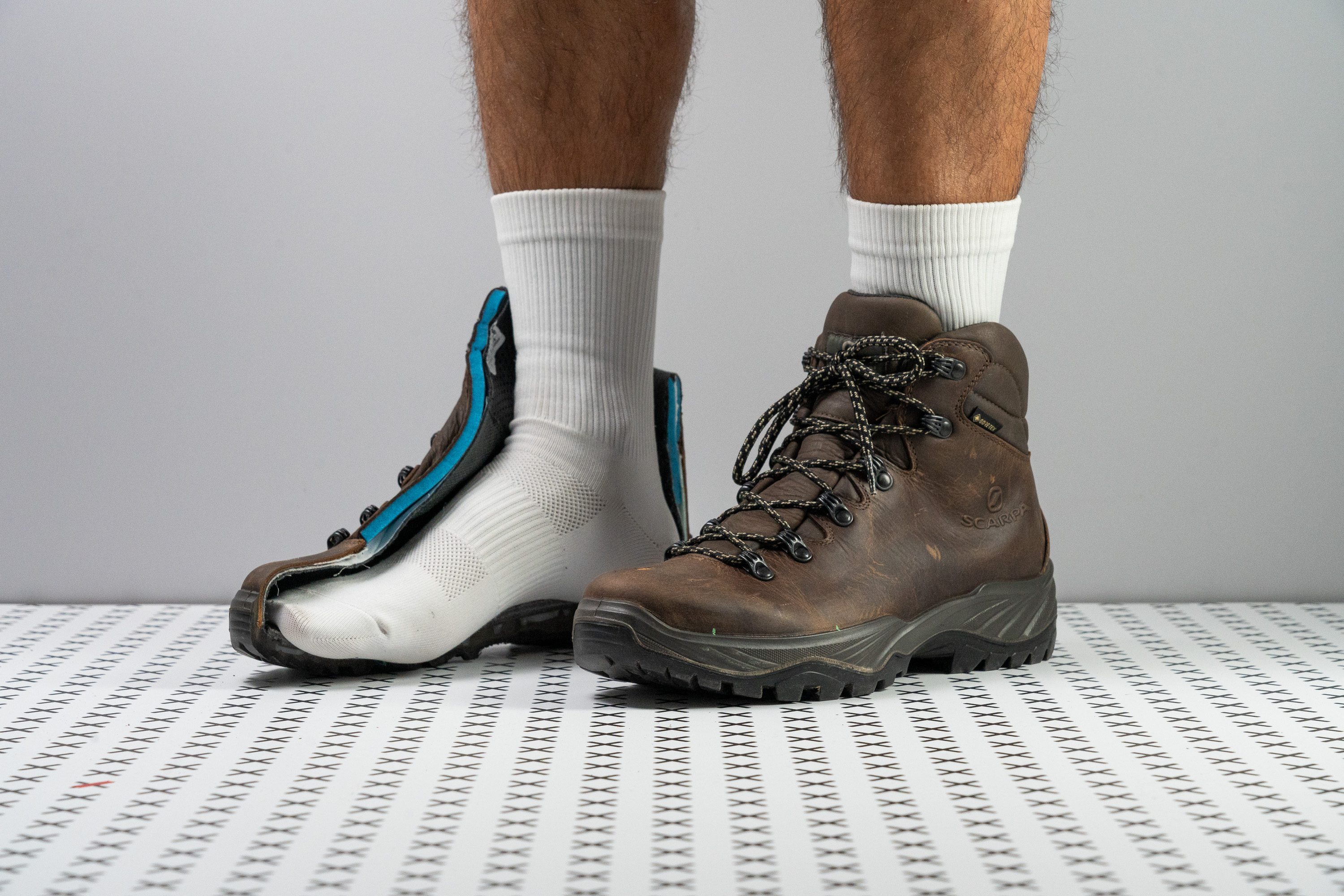







































What makes it the best?
It’s hard to beat the stability and protection Scarpa Terra GTX offers. High ground sensitivity, unmatched traction, and weatherproofing abilities tick all of our boxes, leading us to crown this pair as the best leather boots for day hiking.
The upper is tough on the outside and cosy on the inside. Its solid leather is naturally waterproof and our smoke test further confirms its airtight nature, effectively protecting us from cold winds. No matter how many streams we crossed, our feet remained dry at the end of the day. Its robust exterior even serves as our shield against rocks and roots.
The Vibram outsole works perfectly over a variety of terrains we tackled. It proves its durability in the lab, but what’s hard to ignore is its adhesive abilities. Lined with 4-mm thick and multi-directional lugs, we had all the traction and braking power needed to hike confidently.
Terra GTX keeps us closely connected to the ground through its lower-than-average 32.1/17.0 mm stack and its 16.1% firmer-than-average cushion. Both elements serve as our stabilisers on rocky paths and uneven terrains since we can adapt quickly. The mid-cut boot also ensures firm ankle support without pressuring our Achilles. However, because of its focus on stability, the platform may lack the cushioning others prefer for long days.
Pros
- Glue-like underfoot, even on wet surfaces
- Insanely comfortable
- Reliably stable and supportive ride
- Resilient and high-quality build
- Durable Vibram outsole
- Watertight and warm
- Quick break-in time
- Performs consistently in the cold
- Strong ankle support
Cons
- Quite heavy
- Cushioning could be better
- Scuff magnet
Best lightweight day hiking boots
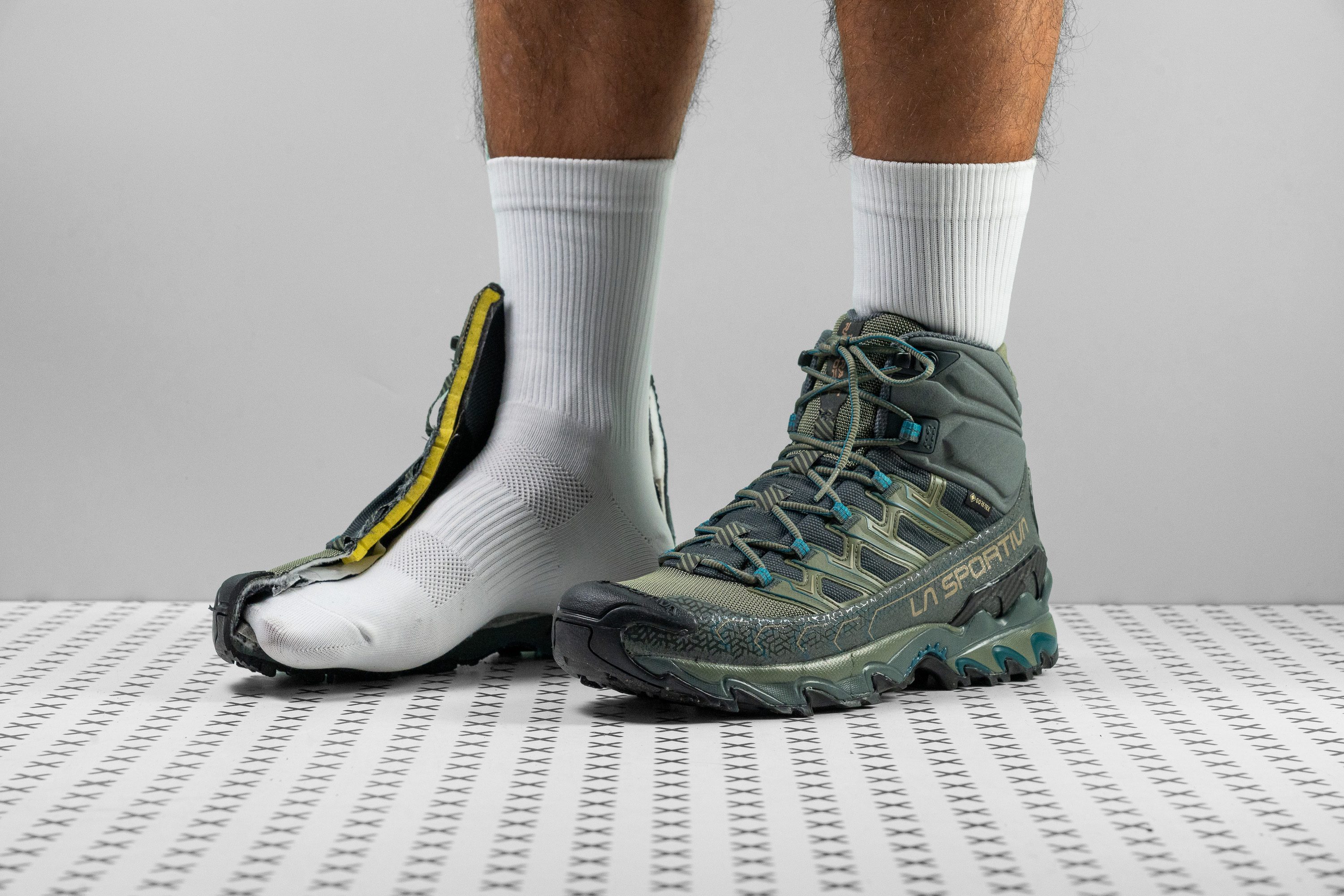















































What makes it the best?
The La Sportiva Ultra Raptor II Mid GTX feels effortless on the move with its minimal and flexible build, making it our best lightweight day hiking shoe. Lab results show its reliable grip enhances trail adaptability, allowing us to speed up instantly, while it offers sturdy support in the right areas.
We never felt burdened while hiking in this pair, and our scales confirm its low 14.6 oz (415g) weight, 21.8% below the average. This boot prioritises manoeuvrability, which is why the midsole bends freely with our feet. In our 30-degree test, it emerged 14.6% more flexible than average. Together with its good energy return score of 44.7%, we felt pretty agile in this boot.
We felt confident moving through changing terrain and elevation because the outsole delivers the traction we need. We measured the lugs at 4.3 mm deep, with various shapes for different purposes, such as braking.
This La Sportiva boot promises ankle twists are a thing of the past, with its structured midsole that received the maximum 5/5 torsional rigidity score in our manual assessment. We also felt its support through the stiff heel counter (4/5), which prevents unwanted movement.
We advise wide-footed folks to skip this boot because its toebox is not spacious enough for broad feet.
Pros
- Unbelievably lightweight
- Excellent waterproofing
- Doesn't let debris and falling rain/snow inside
- Exceptionally robust and durable
- Phenomenal grip on technical terrain
- Not so stiff and firm in low temperature
- Sufficient impact protection
- Highly supportive collar
- Ample flexibility
Cons
- Narrow platform
- Not for wide feet
Most hikers have their “daily driver” pair of boots. That's the one we reach for nine out of ten times when we head out on our local trails. The best daily drivers are often day hiking boots, they’re good enough for the majority of hikes, and for some hikers, they may be the only type of boots you’ll ever need.
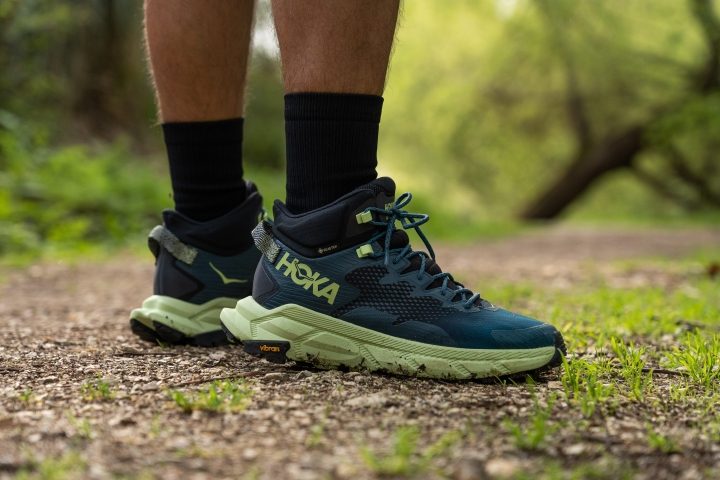
What is a day hiking boot?
Day hiking boots are, by design, what you imagine when you think of a hiking boot, they're all-rounders and are the perfect boot for many hikers.
What are the features of a day hiking boot?
Designed to provide comfort and support for short hikes, day hiking boots usually have a lightweight construction and have greater cushioning and stability than regular running or walking shoes.
The best day hiking boots find the balance between having sufficient ankle support while still allowing plenty of flexibility in the foot area. They also provide good traction on various surfaces on all but very technical trails.
What conditions do day hiking boots perform best in?
Day hiking boots are designed to perform on short hikes, typically on relatively flat terrain. The lightweight construction and cushioning make them ideal for hikes like these.
Factors to consider when buying day hiking boots
As day hiking boots are quite standard boots, there's nothing too specialised to look out for when buying a pair. Just keep in mind the terrain and weather you plan to be in and you'll find a great pair.
Consider the:
- Fit
- Comfort
- Durability
- Weight
- Waterproofing
- Breathability
- Traction
A good fit is vital
The best day hiking boots should fit snugly, but not too tight, around your feet and ankles. Your toes shouldn't be cramped or feel squished in the toe box, as this can lead to blisters and general pain.
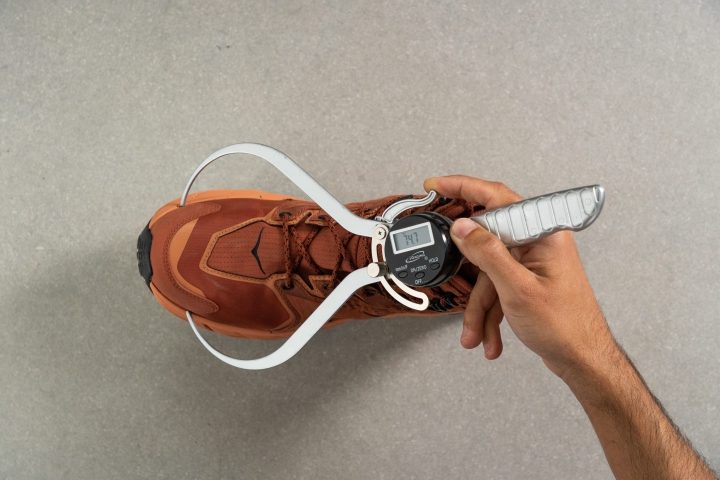
There should also be enough room for your foot to flex when walking downhill. When shopping for a pair of day hiking boots, make sure you try them on with the socks you intend to wear when hiking as this can make a difference out on the trail.
Make sure you're comfortable on the trail
Your boots should be comfortable as soon as you put them on. They shouldn’t cause any discomfort in the ankle, foot or toes and fit snugly to provide support when walking. The cushioning of the boot should also provide enough support when stepping down onto hard surfaces and shock absorption in the soles will help prevent fatigue on the trail.
Durable boots keep you hiking for longer
Try to find a pair of day hiking boots that have been constructed with high-quality materials that will last through multiple hikes. The material should be waterproof to keep your feet dry in wet conditions.
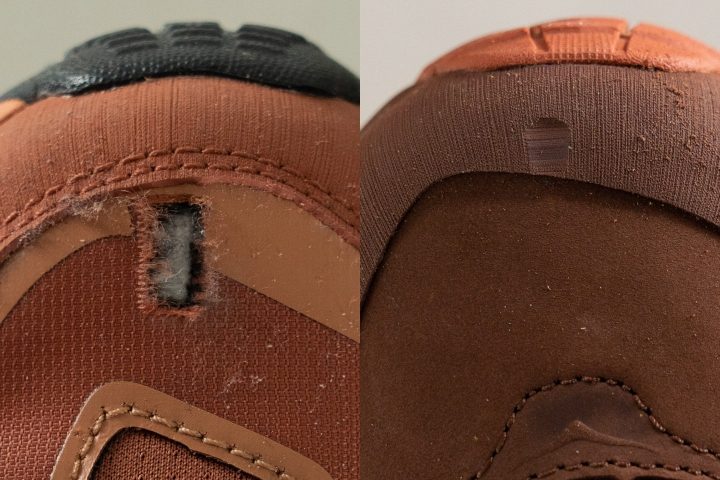
Less weight makes it easier to move
Day hiking boots should be lightweight enough to reduce fatigue and strain on your body when hiking. Look for a boot with a lightweight sole, EVA midsole, and air-mesh upper which all contribute to reducing weight without compromising on durability or support.
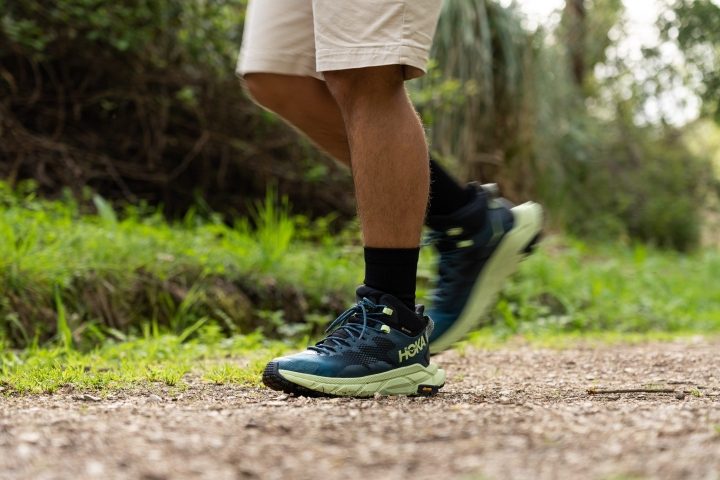
Keep waterproofing in mind
The best day hiking boots should be waterproof or water-resistant to some degree, based on where you plan to use them. Look for a pair with either a fully waterproof membrane or a pair with a water-resistant treatment to keep your feet dry in wet conditions.
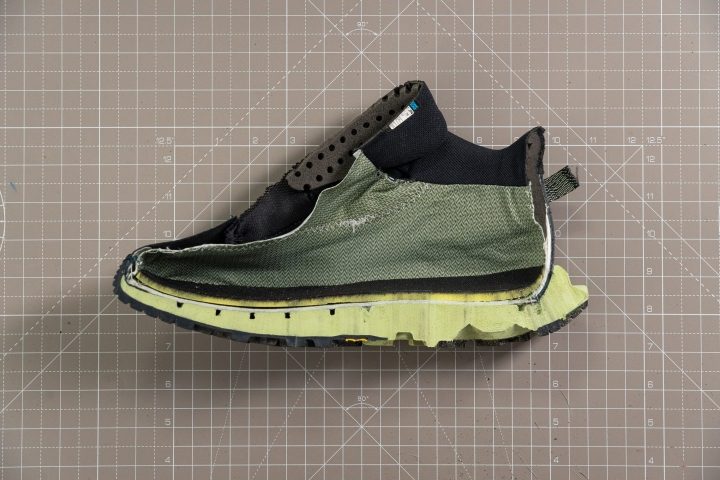
Breathability is important in all conditions
Some of the best-reviewed day hiking boots on the market have breathable uppers to help keep your feet cool and comfortable. Hiking can cause us to sweat and if this can't escape from our boots then it can make moving about uncomfortable and may even lead to blisters.
Look for a boot with air-mesh panels or vents to allow airflow while walking and reduce any build-up of sweat.
Choose an appropriate amount of traction
Hiking boots should provide good traction on a variety of surfaces. Look for grippy lugs with an aggressive tread pattern that will provide enough grip to keep you safe when walking on wet or muddy trails as well as rocky terrain.
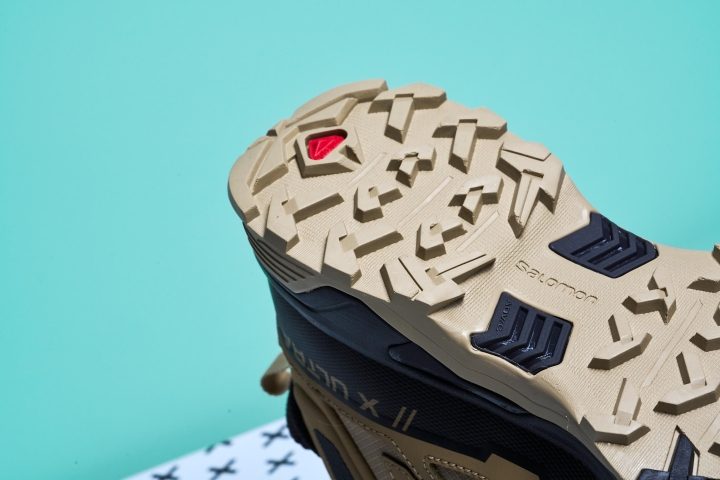
Day hiking boots vs. backpacking boots
Backpacking boots are a great choice if you’re looking for a very durable pair of boots that you can wear on multi-day treks. Here’s how they compare with day hiking boots.

|
Feature |
Day Hiking Boots |
Backpacking Boots |
|
Purpose |
Day hikes |
Backpacking trips |
|
Design |
Sturdy, ankle support, rugged materials |
Sturdy, ankle support, rugged materials |
|
Traction |
Aggressive treads |
Aggressive treads |
|
Comfort |
More cushioning and support |
Even more cushioning and support |
|
Durability |
Designed for hiking, can last for many years |
Designed for backpacking, can last for many years |
|
Cost |
Can be more affordable |
Can be more expensive |
Find out more about the best backpacking boots.
Day hiking boots versus day hiking shoes
Day hiking shoes may be a good alternative if you’re looking for a lightweight option with lower ankle cuffs. Here’s how they compare with day hiking boots.

|
Feature |
Day Hiking Boots |
Day Hiking Shoes |
|
Purpose |
Longer hikes, rugged terrain |
Shorter hikes, less rugged terrain |
|
Design |
Sturdy, ankle support, rugged materials |
Lighter, more breathable materials, lower ankle support |
|
Traction |
Aggressive treads |
Flatter treads |
|
Comfort |
More cushioning and support |
Lighter, less cushioning and support |
|
Durability |
Designed for hiking, can last for many years |
May wear out more quickly |
|
Cost |
Can be more expensive |
Generally less expensive |
Find out more about the best day hiking shoes.
Day hiking boots FAQ
How should I break in my day hiking boots?
Breaking in your day hiking boots is an important part of the process to ensure that your feet are comfortable on hikes. Before hitting the trail, wear them around the house for a few hours each day and walk around with them outdoors. This will help to break them in more quickly and you’ll be assured that you have a great-fitting pair of boots.
How often should I replace my day hiking boots?
Day hiking boots should generally be replaced every 500-600 miles, or once the tread is significantly worn down. It’s important to inspect your boots regularly for signs of wear and tear, such as worn-out laces or holes in the material.
How do I care for and maintain my day hiking boots?
It’s really important to clean your boots regularly with a soft brush or cloth. After each hike, remove any dirt or debris from the upper materials and lugs of the sole. You should also use a waterproofing treatment from time to time to help protect the material from water damage.
Can I wear my day hiking boots for other outdoor activities?
Yes, you can wear your day hiking boots for other outdoor activities like camping or light backpacking. However, it’s important to consider the specific activity you’re doing and choose a boot that’s designed for it. But if you only have one pair of boots, you’ll find that day hiking boots are amongst some of the most adaptable.
Should I buy day hiking boots with ankle support?
Whether or not you should buy day hiking boots with ankle support depends on the type of terrain and difficulty of the hikes that you typically do. If your hikes involve more rugged terrain, then it's a good idea to opt for boots with higher ankle support. On the other hand, if you're mostly doing trails with well-maintained paths, then you mightn’t need the extra ankle support.
Should I buy day hiking boots with a wide or narrow width?
The best way to determine whether you should buy day hiking boots with a wide or narrow width is to try them on and see how they fit. If your feet feel cramped in the boot, then you may want to consider a wider width. However, if the boot feels too loose on your foot, then a narrower width may be better.
